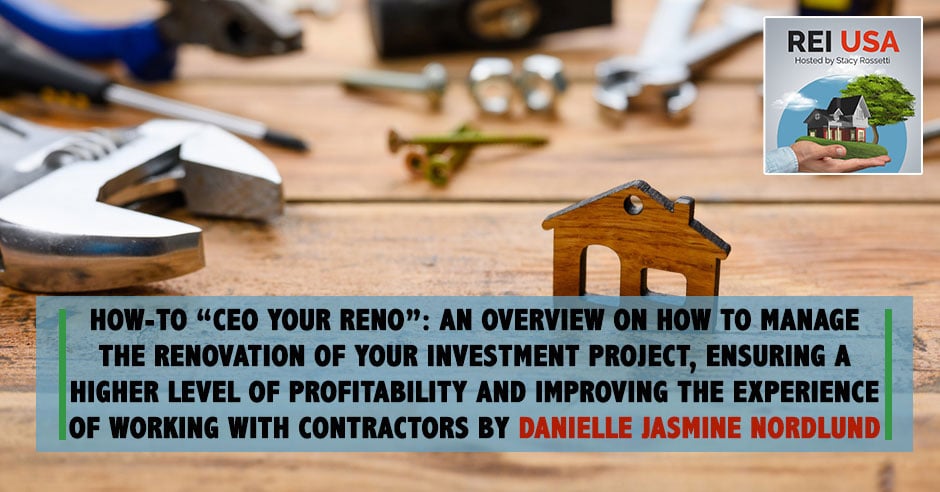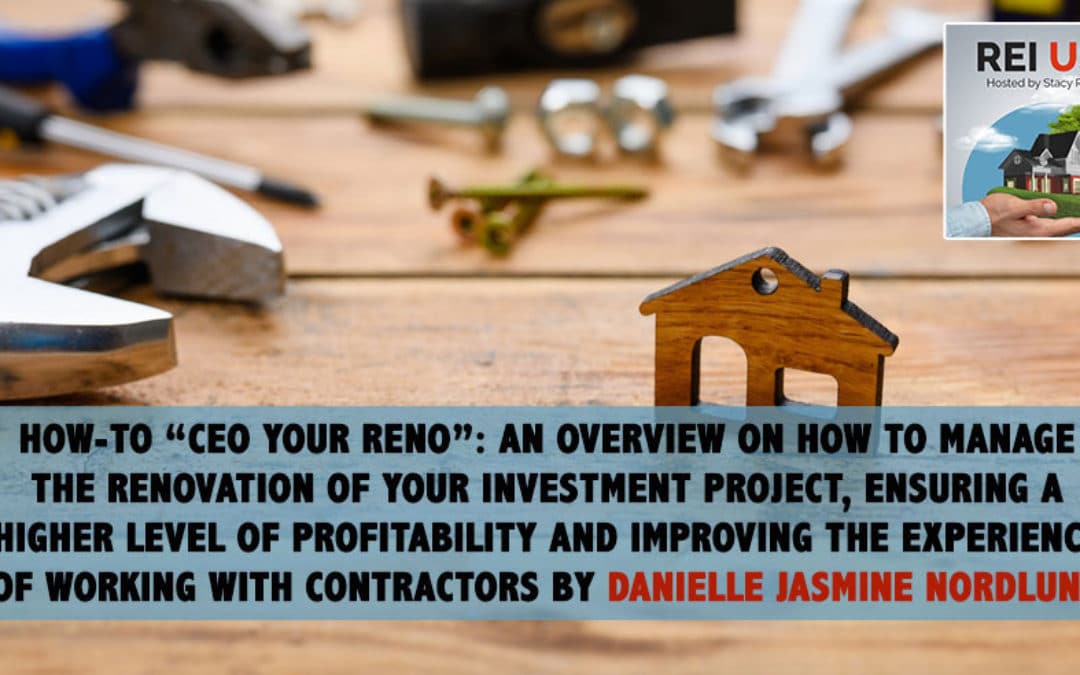
Renovations can often have real estate investors in a frenzy. There’s financing the project, finding contractors and sourcing material. This is stressful, to say the least. We’ve got help on the way for your renovation projects! Meet Danielle Jasmine Nordlund, Director of Design & Project Management at M2REST. Danielle is here to give a rundown on the mindset and give us a look at her renovation process. So, sit back and get ready to take notes as Danielle teaches us her renovation mindset.
—
Watch the episode here
Listen to the podcast here
How-To “CEO Your Reno”: An Overview on How to Manage the Renovation of Your Investment Project, Ensuring a Higher Level of Profitability and Improving the Experience of Working with Contractors
I’m calling this How To CEO Your Reno. It pretty much talks about what my process and philosophy are for investors in dealing with construction management but before we get into that, I want to tell you a little bit about myself and what I’ve been up to. My name is Danielle Jasmine. I’m a Real Estate Investor and Licensed General Contractor. My brand and company online is Jasmine Design & Build. We also have our umbrella company, which is called M2REST. It’s where we list all of our retail flip properties and do a variety of investment strategies and then RESource ATL, which is our newest wholesaling brand company that’s been running for the past few years.
I’ve got several years of experience and it’s a multi-faceted business at this point. My primary focus is rehabs, new construction, short-term rentals and long-term rentals. We also do wholesaling, lending and consulting. At any given time, I’m managing 5 to 7 build projects. I’ve got thirteen short-term rentals. I’m building out four more. All of my short-term rentals are my builds. I love that approach to it. We’ve got fourteen long-term rentals.
Building The Right Team
This is important too because I like to talk about my team. A lot of people present and share about their business and what they’ve accomplished. My question is always, what does your team look like? What’s the village that gets done everything that you do? It’s been our business as a whole. My husband, Malhar Bhagat, is my life and business partner. He’s been investing for that long. I joined years ago but throughout that process, we have strategically built out a team for various areas of our business. This is what it looks like and we’re also rapidly growing. We’ve got three business partners, myself, my husband. Josiah Quansah is our partner in our wholesaling business, Resource ATL.
We have a construction project manager. That’s been a game-changer for me. He does a lot of onsite project management. I’m not on construction sites every day but rather walking them once a week. That’s been a big deal for us in our business and ability to scale. We’ve got an acquisitions manager, office manager, transaction coordinator and bookkeeper. We’ve got a data entry social media support VA that’s full-time and then we’ve got three full-time wholesaling VAs.
We’re also in the recruitment process for a full-time carpenter to be a number two underneath our onsite project manager. Also, an office field assistant for our short-term rentals and that’s key because they become quite the management and maintenance time-suck, to put it lightly. They are a beautiful thing because the cashflow has been amazing for our business.
As we scaled them and we’re going to have seventeen within the next months, we need more than our office support to be able to run them out in the field. With all that said, that’s our team. I am very passionate about inspiring and empowering people to do and manage their construction. I’ve spent years figuring this out myself, so I like to share and inspire others based on what I’ve learned so far.
[bctt tweet=”It’s important to get clarity behind the experience that you want to have. What gets fired gets wired.”]
How To CEO Your Reno is the mindset approach to managing a construction renovation investment project looks like. The goal is to have a higher level of profitability and improve the experience of working with contractors. This mindset and approach extract instruction, it’s not related to wholesaling, although mindset applies to everything as we know but specifically that. One of the gaps I’ve seen in real estate education out there is that there’s not a lot of focus on how to manage that process.
This is what that’s focused on and what it’s about. These are the things I’m going to cover, the mindset around it, team members, some tools of the trade, scope of work, home inspections, budget spec sheet and then hiring contractors, managing the relationship and starting with the estimates, which is where the first start of your relationship with them.
This is all about the mindset around it. The general approach is that I have talked to countless investors through the years, and I have had countless people because I’m a contractor. Countless investors come to me wanting to build homes for them for their investments. It’s not something I do. I only do my investment projects, but I’ve been privy to the approach that investors take to it and realized that there’s a gap there in looking at how to establish that relationship and how to manage it as a whole.
The Renovation Mindset
Touching on mindset, there is so much information out there, the so-called reality TV, about renovation projects and investments. None of it is reality-based. None of the numbers are super accurate that we all see. The process is edited down to 30 minutes or a 1-hour show, a project that could take up to a year or longer. There is a lot that goes into it that isn’t shown. It’s presented in the best possible light. I too fell in love with home renovating and flipping via reality TV. It’s enjoyment and entertainment for everyone but it is like the rosier side of the process.
There are things that people have heard of and experienced in real life, the reality behind it. The so-called money pits or stories about, “How a contractor did me wrong,” and how people ran out of money, didn’t budget correctly, anticipated things or poor-quality construction. There are countless stories in our network of these things happening and things that have gone wrong.
My advice here is that you can’t wipe all of that clean but what’s important is to get clarity behind the experience that you want to have. What gets fired gets wired. With all of this other stuff having gotten fired, what you need to wire for yourself is your intention behind it. Outline your approach and the energy you want to put into it, the relationship you want to have with all of your team members.
Specifically, CEO Your Reno is about being the CEO overall of your investment project. That means the onus and responsibility that you have to bring all these pieces of the puzzle together and all these team members together to have the best, most profitable output of your project for yourself. It’s about sitting in that position and figuring out what expertise and what people you need in all the different roles to have that best possible outcome. Getting clear about that and taking ownership and initiative when it comes to that, it’s all about accountability for yourself.
A big misstep is that people put all the onus on contractors. They search for contractors and go through a lot of them. Their approach isn’t always the best but it’s holistic. A contractor is one team member among a full team of people that are going to get you to where you need to be with your construction project. That’s all about mindset and the approach that you want to be taking.
Leading Your Team To Success
When we talk about these team members, this collective that needs to happen with you at the helm as the investor, driving the ship, you have to make up for the lack of experience that you have because, most often, you don’t have the experience. I’m assuming you’re not familiar or experienced with construction yourself going into this. Hence, you have to hire a contractor or you’d be building it yourself.

Renovation Projects: Having a home inspector is key to making up for your lack of experience and education when it comes to construction.
There are all these other areas as well. This is the core list of members that you want to be recruiting for and building relationships with. Your lender is about money and having the capital lined up to fund your project, the purchase and then also the build-out. I don’t feel like people put enough importance and emphasis on the home inspector. When you don’t have that construction knowledge, having a home inspector who inspects your home for a pre-build and a post-build is so key to making up for your lack of experience and education when it comes to construction. Also, to inform your scope of work and what’s needed with your contractor.
Your contract, the person that you hire to build the property out, you need a surveyor, architect or a draftsperson depending on the municipality you’re in. A permit expediter, some people have easy and very simple permitting processes. I live in the City of Atlanta, not so much. The permit process can take a year or longer. It’s key to have somebody designated to push that permit through to get it. An engineer is key too. If you’re working with a draftsman, you’re going to need an engineer to review and stamp plans. Always have an engineer come in and be able to inspect things and provide a letter if needed, depending on the scope of your project.
A designer, maybe you’re the designer. Maybe you’ve never designed a home before and you should hire somebody else to design. Regardless of how you set it up, somebody’s role is designated to design the property, so you’re not winging it along the way. There’s a cohesive design for the home. Your agent to sell the property is key. Having an agent who is very knowledgeable about the market and also very investor-friendly so they can work with you throughout the process and educate you, look at comps and things of this nature.
I talked about this being a big puzzle. It requires problem-solving, creativity, resourcefulness and how much one has of these skills determines the outcome. All of these people have been working on these puzzles for years. The good news is you don’t have to figure it all out. You have to get good at finding and recruiting great team members to work with and building off of that. That’s the key. Working and recruiting out for your team 100% is the first start to the entire process.
Some of the tools of the trade are a scope of work, home inspections, a budget and a spec sheet. There are a lot more tools that I utilize, but these are some of the basic ones that are key that I wanted to share with you. It goes back to that each member of your team plays a crucial role. For them to fulfill that role and piece of the puzzle, they need some direction. The only person with this overall vision and plan is you. I’m emphasizing that.
You know what you want to have built based on your comps and whatever your investment strategy is. You know what you want the return on your investment to be. You are hiring and managing the team to make it all happen. With all that, you are responsible for ensuring that everyone you’ve hired and are managing has the necessary information to fulfill their role.
The Importance Of Your Scope Of Work
The main tools are these tools. There are lots of different approaches to the scope of work. I’ve seen them have built out in a variety of ways. A lot of times, homeowners or even contractors will have the scope of work templates that they use that are broken down based on the rooms. There will be bedrooms, a bathroom and then a kitchen. However, that’s not the way things are built, priced out or scope is provided for all subcontractors. I created very early on in my build management career a scope of work template that works for me based on how I found things were most often priced out and managed from a general contractor to their subcontractors.
I spent years managing contractors before I became one myself. I realized I glazed over that a little bit. I didn’t go into detail behind that but to give you the backstory, that’s what my inspiration was for becoming a contractor. I have been through many experiences, many not so great but then many that were fine that we made it work. I figured out where the gaps were in their ability to manage a project effectively and I filled those gaps.
Throughout the process of hiring contractors, I learned how to spoon-feed information and provide it in the best, easiest way so that they could best manage my investment project. What I realized is so often, they fell short with disseminating the information that I provided to them to the subcontractors. I always found ways to make that process as streamlined as possible.
[bctt tweet=”You are responsible for ensuring that everyone you’ve hired and are managing have the necessary information to fulfill their role.”]
Utilizing my scope of work was the first step, and then there are lots of tips and tricks that I used throughout the process as well in terms of walking the project during certain times, printing and labeling certain things so that all the subcontractors would have the information they need about the end design that I wanted as well.
Starting with this scope of work, you got your main job summary and all that, but it’s broken up into how people do the work. You have exterior carpentry, siting, handrails, deck and fencing. These are things that are typically traded out with the same subcontractor. Roofing gutters, you’ll have a gutter guy over a roofing guy but concrete masonry brickwork. It lumps up all the different types of work on the project into these different areas. You go through here. Building up this scope of work without any construction knowledge would be very tricky for the average person.
The goal here is to bridge that knowledge gap. I talked about home inspections. I get all my inspections done pre and post-build. A lot of people ask, “You’re managing the project. Why do you get post-build inspections done?” I do not crawl into every inch of my crawl spaces, basement or attics after my attic blowing has been done or all my trades have come out and done all their set-outs. I don’t inspect a home to the micro-level that a home inspector will. It’s also a fresh pair of eyes so that I can tell what a home inspector would come up with who was purchasing the home.
It informs my punch list. It makes sure all my systems are working correctly and certain building standards have been adhered to. That’s the opportunity for me to have my trades come through and address any issues before we even put a home on market for sale. Different home inspectors all have different things but I wanted to point out that they list things in.
For example, area of damage facia, this is a typical item that would be in your home inspection. What you would do is copy and paste. You would go to that exterior carpentry, put in under siding, outline those things and then reference inspection page numbers. You can say per inspection report with specific page numbers reference, so it’ll be provided in your scope of work. You’re spoon-feeding it to reference it and look at it. That’s a key part of the process there. That’s a scope of work and then the home inspection informs that scope of work.
We also have a budget and spec sheet. I utilize my budgets for my initial setup budget but then also for some accounting because they helped me manage the cost structure of the project as I go along. We have a cool template that we’ve built out that gives you projections based on square foot count, the projected overages based on what you’ve spent per line item and things of that nature. The budget is key.
Another option too is to have a contractor, highlight depending on the level of technology savvy your contractor has. This could be something you print out and they write out. If it’s a cosmetic renovation and they’re not a full scout scale builder and it’s not needed, you could have them write out some costs so it could serve as a rough budget for your contractor that you establish but I always recommend that you have an ongoing budget where you’re keeping track.
I’m the contractor myself, so I have lots of transactions that I manage throughout the budget. However, this could be your draw schedule, things that you might purchase for the home and then the draws that you’ve paid out to your contractor. It would look a whole lot simpler, depending on your level of involvement with the build process.
The scope of work, actual home inspections that inform the scope of work, the budget and then a spec sheet is key too. This spec sheet is something that you would also want to be working on. You might not always have this completely figured out at the start of your project but the key here is that you have some tool that tracks your actual design picks for the home because you do not want your contractor designing your home.
If you hired a contractor who does design and builds all in one, that’s awesome. They are very expensive or maybe it isn’t the best design that you’re looking for but this is something I’ve heard or seen from investors in the past. Even if you want the input of your contractor on the design because they have more experience doing projects than you, i’m assuming this is newer for an investor. That’s the approach here. Even if that’s the case, you still want something tracking it. You want to be ready and prepared when that information is necessary during the build process.
The example that I always like to point out for people is that inexperienced investors might go into a project and think that they have a couple of months before they have to pick out all of their fixtures. That is not the case because the number one thing that you see that’s always like, “What were they thinking,” or a little askew in home design that I see is where your shower and tub fixtures don’t correlate with other fixtures in the home.

Renovation Projects: Every contractor is going to want to be building a relationship and not be a one and done investment project.
The reason for that is that the valves for those need to be installed with your rough-ins. A rough-in period is a period after you’ve worked on foundation, framing, home sealed tight and airtight. There’s this rough-in period where inspections happen after all your plumbing, electrical and mechanicals have all been in there to rough the home in. During that period and right before they do all that work, it’s key that the design choices that you have in mind for the home are relayed to the contractor because the placement of everything would be very painful to change after the fact.
There’s an order of operation in construction. It’s one of the things when you go into a home, you might walk somebody’s project. If they’re framing in one room, sheetrocking in another and tile in another, that’s an indication that they’re not very organized. They don’t have a specific timeline and trades that come out to do specific things. That’s always a little bit of a red flag to me.
You need to have those fixtures chosen in advance so that the valves installed will be compatible with your matching trim set out. That’s your handles, so your shower handles will match your faucet because you’ve decided on them ahead of time, early on in the project. Having a spec sheet is great, where it covers your electrical, plumbing, paint and flooring tile. This is key because even though this one isn’t finalized, normally there are SKUs and model numbers in here for appliances that are great reference points. Paint is key.
The reason for that is we provide those spec sheets to the people that we sell the homes to. It creates a process that is so much more streamlined as far as that new homeowner being empowered to go out and get the correct light bulbs for their fancy chandelier, paint to do paint touch-ups, get grout to regrout their backsplash in their kitchen when it cracks because it’s natural. It happens with construction.
It mitigates a lot of the information that’s needed in the back and forth after you sold the home when you provide this information on the onset and then they’re empowered. If they have an issue with their appliances, contact the manufacturer and it takes you out of the middle of that. That’s something we’re big on.
Build A Relationship With Your Contractor
Jump to vetting and hiring contractors because out of that whole team, that is the most thing that I’m asked about and I have found that people struggle with specifically building those relationships with contractors. It’s often a painstaking process for anyone and it’s even more difficult for women. That’s not to say that I looked at it as a disadvantage being a woman in this industry. For years, I did look at it that way. I had a mind shift at a certain point and this was in line with my decision-making years ago to become a contractor myself as well, where I realized all of the attributes I was bringing towards a process because I was a woman.
Also, the attributes that I have myself. I’m a great project manager. I was able to take these on with that approach but specifically, being a woman, there are things, not to be stereotypical, that come a little easier for women. Building rapport, relationships and actual respect for the work and the craftsmen that build the home is something that came naturally for me. Also, the multitasking, being able to hold it all in, realize what was happening and being able to know a little bit about every area to bring it all together collectively.
Whether you’re a woman or man, regardless of how you identify, that’s very much feminine energy collectively where it’s like, “How do we bring this village together?” That was my approach to this. These are some of the tactics that I established in vetting contractors. You need to assess their experience and that’s through conversation. You want to ask tons of questions.
[bctt tweet=”People struggle with building relationships with contractors. It’s often a painstaking process for anyone, and it’s even more difficult for women.”]
Stepping back, even in the initial approach to contractors, it’s about building a relationship. What not to do? Do not approach as many contractors as you can get in touch with asking for them to bid out your project. It’s not appealing or interesting. This is a very busy market. If you are a good builder, you are extremely busy, so you do not need to search out a lot of work.
Granted there are lots of contractors out there who have full built-out teams where they do a lot of advertising online, they’re able to send out multiple crews for different things, so they might recruit for work and handle it that way but in general, every contractor is going to want to be building a relationship and not be a one-and-done investment project.
That needs to be the approach with any contractors that you’re reaching out to because getting bids to compare numbers, especially when they’re not apples to apples, if there isn’t a scope of work in place already, then you’re asking for bids based off of a judgment of a contractor without an overall vision of what the scope of work is. Nothing’s going to be apples to apples and it doesn’t make sense. It’s not a smart approach to it.
Instead of wanting to build that relationship, have a conversation with them talking about your project and whether or not it would be a good fit. You discuss your high-level budget. If you have a budget in mind, can you discuss what that budget is? You also talk to them and ask them questions about their experience with budgets and price per square foot. Not every contractor is going to know offhand, “I build at this price per square foot or that,” because they might not be as savvy or have a fancy budget template like me where they track these things. However, they will have a general sense, based on your scope of work what a realistic budget is for.
Know Your Stuff
That’s key to start it with a conversation and those kinds of topics to see if it would even be a good fit. You talk about your roles. Your role being the money, the project management and design and theirs being to build and manage the subs and material. That’s key as well. You don’t want to put all the onus on a contractor. It’s talking about what you’re bringing to the table and giving them confidence in your ability to keep the money flowing.
As many investors have horror stories with contractors, contractors have horror stories with investors that don’t have money. It dries up and doesn’t have realistic budgets. They get in over their head and make promises they can’t keep because there’s not enough money flowing. That’s your role that you need to take very seriously because if somebody is doing all the management of material and work, they need to trust that the money and capital will be there to keep the project flowing and then the other team members you have and bringing them all together.
Setting up expectations on payments and timeline is key. You can have a payment schedule. Make it a part of your contract and it’s very clear for them what the payment expectations are according to the specific phases of a project. Without getting too deep, it needs to be established based on whatever your inspections are as well. That’s a way for you to keep the accountability there, after rough-ins pass is when you pay your rough-in draws.
Having your paperwork overall straight, the scope of work, a contractor’s budget payment, draw schedule, certificate of insurance, license verification and driver’s license. I can’t tell you how many stories I’ve heard and seen homes being built next door to a home I’m building where they sit at that point in the project. Most often, you see investors walk away from deals when a home is framed up and maybe roughed in, maybe not, but it stops there.
The reason is that if the right permits aren’t placed, the license subs haven’t done the work to pass inspections and those trade permits haven’t been pulled, then the work stops because you can’t move forward at that point. It’s key to confirm all these at the onset. Everyone likes to say they’re a licensed contractor and it is so crucial that you verify that license.
You can do that in a way that isn’t insulting. Everyone shakes your hand and says, “I’m a licensed contractor.” “That’s awesome. Are you the license holder?” It’s the question I used to always ask, “Do you have a partner?” Often it’s a partner that they have and this partner may or may not be involved in the process or they may have someone pulling permits for them. It’s key to know what you’re getting into in terms of that relationship and an actual holder of the license, the insurance and how much involvement they have with the build-out of your investment project. That’s a little bit about vetting contractors.

Renovation Projects: Establish what your budget is first based on your comps, based on what the home actually needs to improve. Then come up with a scope of work that fits into that budget.
We’re going to touch on some estimates. The initial start of any conversation once you’ve talked to contractors about specifically the relationship, if it would be a good fit, you’ve already talked about the scope high-level, the budget, you’re at the phase where you want to move forward and figure out based off of your scope of work that you’ve created that you want to get their pricing and information from them to see if it’s going to be a good fit economically for your investment.
Everyone Needs To Profit
Different contractors structure out their estimates in different ways where some will have their overhead or profit built-in and then others will have a breakdown of the labor and material if you’re lucky and it’s a full disclosure because you’re seeing all those different costs but a lot of investors are uncomfortable seeing it separated because then they get to see where the profits built-in. Unfortunately, that is not something that every investor feels comfortable with. It’s a shame because then it gets to a place where you’re cutting here and there.
The point that I want to make here is do not be the investor that doesn’t want everybody to eat. John Stafford says, “Everybody eats.” That is one of his favorite phrases and I love it because your approach to this, if you want longevity in this industry, is to build a team where everybody gets to grow and eat together. Looking at it from that perspective where your contractor has their profit-building, having realistic conversations about what that profit is and how they’re including it in there is an important part of this process.
Don’t let it be where you’re trying to eliminate their profit out of the deal because that’s the only way that they’re making money. It’s going to be based on how much disclosure they want to offer. It’s not one wrong way or one right way. If I was going to build for investors or other people, I would do cost-plus because I would want it to be very clear from the onset.
“This is my overhead and my profit. Anything we spend is solely up to the market conditions, the desires of different building materials and different things that come up that we are not aware of during the build process. My profit is separate from that.” I am ensuring that I’m going to get paid on the deal, not work for six months for no money. It would have to be with investors who are comfortable with that and seeing those numbers broke down that way.
Common construction management overheads can be 10%, 15%, 20% based on the experience, the skill level and the license that they have. If you’re doing a very quick cosmetic renovation, you might get somebody who doesn’t need to be licensed, it’s an overall project manager and they might make 10% on it. You won’t even need all the costs to be broken down separately.
However, it grows from there. If you are doing trade work where you need licenses and inspections, it’s going to grow to 15%, 20%. The approach is that you want to do multiple projects and build a relationship with a contractor but they’re not going to give you a discount on your first project without that being proven. Discounts are received when you give more work overtime. I’ve been able to have better pricing with all of my subcontractors because I work with them consistently and provide so much work for them.
My rule of thumb is to always shoot for a fair middle ground. If I was not a contractor myself and I was recruiting for contractors to build projects, I would have honest conversations with them and be perfectly comfortable paying 20% if they were a good contractor who had the planning, timelines, their budget is managed appropriately and had a good team of subs that were going to ensure the quality construction that I was looking for. It would be up to me to figure out how to find and locate the deals that work and the scope based on that budget.
One of the common things we talk about a bunch is that you always want to budget to your scope and not scope to your budget. What that means is that you don’t want to come up with a scope of work without any clarity on what the budget would be because then what you’re doing is you’re cinching down the scope of work to try to meet it into the budget. It’s always going to be a sacrifice in quality, timeline or something. It’s key to establish what your budget is first based on your comps, what the home needs to improve. Coming up with a scope of work that fits into that budget is key.
Important Links
- Jasmine Design & Build – Instagram
- M2REST
- RESource ATL
- REI USA – Facebook group
- http://www.rei-usa.com/membership/
- http://www.REI-USA.com/trainings/
- http://www.REI-USA.com/ teachers-spotlight/
- http://www.rei-usa.com/free-template/
- https://www.instagram.com/reiusa_/
- Free Online Jumpstart Course for Real Estate Investing: https://bit.ly/3IrDji9
- REI USA Youtube: https://bit.ly/36QPoQl
- How to Get Started Investing in Real Estate: https://bit.ly/3pIxB4r
- Talk to Kristi, Our Community Manager, for a FREE 10 Minute Website Demo: https://bit.ly/3pIxB4r
About Danielle Jasmine
 Danielle Jasmine. Danielle is a licensed general contractor. She is also the Director of Design and Construction Management for the well-known company M2REST
Danielle Jasmine. Danielle is a licensed general contractor. She is also the Director of Design and Construction Management for the well-known company M2REST

